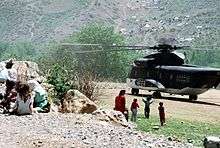Army aviation
| Army aviation | |
|---|---|
 | |
| U.S. soldiers in OH-58D Kiowa and AH-64 Apache helicopters conduct a combat air patrol in Iraq |
An army aviation unit is an aviation-related unit of a nation's army, often described as an air corps. These units are generally separate from a nation's dedicated air force, and usually comprise helicopters and light support fixed-wing aircraft. Prior to the establishment of separate national air forces, many armies had military aviation units, which as the importance of aviation increased, were spun off into independent services. As the separation between a nation's army and air force led to a divergence of priorities, many armies re-established their own organic aviation branches to best serve their own needs.
History
Military aviation first began as either army or naval aviation units established as force multipliers to allow armies and navies to better do what they were already doing, this taking mostly the form of reconnaissance and artillery spotting, this led to the first fighter aircraft whose purpose was to shoot down enemy reconnaissance and artillery spotting aircraft, and to protect one's own aircraft from being shot down. At this point the purpose of aircraft was still to act as an adjunct to traditional armies and fleets operating in the traditional way. However, as aircraft became more technologically sophisticated military theorists of the interwar period began to think of airpower as a means in and of itself where the critical blow could be delivered by strategic bombing, and the experience of World War II seemed to confirm this. Post World War II air forces such as the Royal Air Force and the newly established United States Air Force concentrated on building strategic bomber fleets for attack and fighter fleets to defend against enemy bombers. Where it existed tactical bombing took the form of air interdiction missions, these air forces having lost interest in tactical reconnaissance in support of commanders on the ground and in the "taxi rank" type close air support missions, in which aircraft acted directly in concert with and at the call of soldiers fighting on the ground.
In order to acquire a close air support capability armies sought to expand, establish or re-establish their own aviation branches, however in order not to diminish their own standing and funding most air forces take an "if it flies it belongs to the air force" attitude. Today a compromise fairly typical the world over is "if it has wings it belongs to the air force", allowing the army to operate helicopters and light fixed wing aircraft.
With the development of unmanned aerial vehicles some armies have begun to use battlefield UAVs, being not attached to army aviation units, but to for example artillery units as spotters, and with the smallest and lightest drones being deployed by individual infantry squads to provide real time local reconnaissance.
Tasks
.jpg)




The tasks of each army's aviation units are defined slightly different, depending on nationality. Some general characteristics, however, apply to all army aviation units regardless of provenance:
- Offensive action (Anti-tank warfare, air assault, fire support, and rarely air-to-air combat, as part of a combined arms team)[1]
- ISTAR (Intelligence, Surveillance, Target acquisition, Reconnaissance)[1]
- Logistic and battlefield support
- Tactical transport both internally and externally, of personnel and material
- Search and rescue
- Medical evacuation
- Liaison
- Flying training
- Disaster relief
Equipment
In order to fulfill their manifold tasks, army aviation mostly uses helicopters. These helicopters can be classified into the following categories:
- Attack helicopters for close air support of ground troops and anti-tank role
- Transport helicopters
- Observation helicopters
- Utility helicopters
- CSAR, Casualty Evacuation (CASEVAC)/MEDEVAC helicopters
- Training helicopters
In addition to helicopters, many armies also operate fixed-wing aircraft. They include the following categories:
- Reconnaissance
- Surveillance
- Transport
- Airborne command post
List of national army aviation components
.jpg)
- Argentine Army Aviation (Argentine Army)
- Army Air Corps (United Kingdom) (British Army)
- Army Aviation Corps (India) (Indian Army)
- Australian Army Aviation (Australian Army)
- Brazilian Army Aviation Command (Brazilian Army)
- Colombian National Army Aviation (Colombian Army)
- French Army Light Aviation (French Army)
- German Army Aviation Corps (German Army)
- Hellenic Army Aviation (Hellenic Army)
- Islamic Republic of Iran Army Aviation (Islamic Republic of Iran Army)
- Malaysian Army Aviation (Malaysian Army)
- Nepalese Army Air Service (Nepal Army)
- Pakistan Army Aviation Corps (Pakistan Army)
- Portuguese Army Light Aviation Unit (Portuguese Army)
- Spanish Army Airmobile Force (Spanish Army)
- United States Army Aviation Branch (US Army)
See also
References
- 1 2 "Army Aviation Role". British Army. Retrieved 1 August 2016.
Further reading
- Allen, Matthew (1993), Military helicopter doctrines of the major powers, 1945-1992. Making decisions about air-land warfare, Westport (CT): Greenwood, ISBN 0-313-28522-5
- Gunston, Bill (1981), An illustrated guide to military helicopters, New York: Arco Publishing, ISBN 0-668-05345-3
- Halberstadt, Hans (1990), Army Aviation, Novato (CA): Presidio, ISBN 0-89141-251-4
- Sutton, John; Walker, John (1990), From horse to helicopter. Transporting the British Army in war and peace, London: Cooper, ISBN 0-85052-724-4
- Warner, Guy; Boyd, Alex (2004), Army Aviation in Ulster, Newtownards, Co. Down: Colourpoint Books, ISBN 1-904242-27-8
- Young, Ralph B. (2000), Army aviation in Vietnam. An illustrated history of unit insignia, aircraft camouflage and markings, Ramsey (NJ): Huey Co., ISBN 0-9671980-1-1
External links
![]() Media related to Army aviation at Wikimedia Commons
Media related to Army aviation at Wikimedia Commons